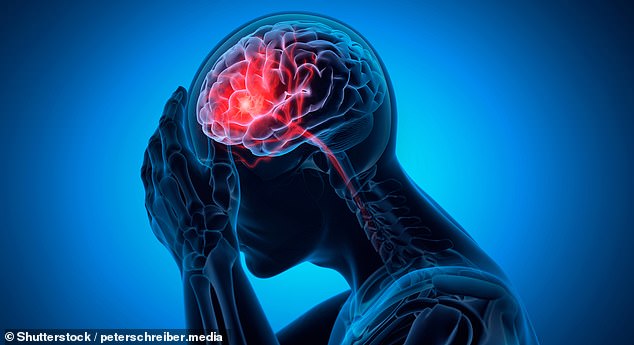Millions of young adults suffering from migraines could be at increased risk of a potentially deadly stroke, a study suggests.
Finnish researchers analysing health data from more than 1,000 adults under 50 found those suffering from the painful headaches, had a 70 per cent increased chance of a stroke.
This was despite migraines, a condition which affects about 10 million British patients, not being considered a traditional risk factor for strokes.
The authors have now called for medics to ask patients, particularly young women who are innately at higher risk of stroke than men, about their migraine history.
This new research follows a general mysterious rise in strokes in the under-50s in recent years.
In the new study, researchers examined potential risk factors for ischemic strokes, those that occur when the blood supply is cut off to the brain such as due to a blood clot, among young people.
The scientists, from the University Hospital in Helsinki, were particularly interested in what are called cryptogenic strokes, those with no known obvious medical cause like high blood pressure.
To do this, they took 523 stroke survivors and matched them to 523 healthy counterparts.

Millions of young adults suffering from migraines could be at increased risk of a potentially deadly stroke, a study suggests
They compared traditional risk factors for stroke, like high blood pressure, and ‘non-traditional’ ones like migraines.
The scientists found each non-traditional risk factor was linked to a 70 per cent increased risk of stroke.
In contrast, known risk factors only increased the risk of the medical emergency by 41 per cent.
While the increase sounds large, the base risk of a person suffering a stroke in the first place is quite low.
For migraines with aura specifically, the researchers calculated these were present in about 23 per cent of people who suffered a stroke.
However, this rose to 46 per cent among a subset of patients with a common heart condition called patent foramen ovale which is where a hole between the upper chambers of the heart.
This hole is present in all babies as they develop in the womb.
While it normally closes shortly after birth, this doesn’t happen in about one in four people.
The hole is considered generally harmless but patients with condition are known to be at slightly higher risk of strokes.

Other – just as common – tell-tale signs of a looming stroke, often fall under the radar. These include sudden numbness on one side of the body, sudden vertigo and difficulty swallowing
Lead author of the study, stroke specialist Dr Jukka Putaala, said the strength of the results linking migraines and strokes were surprising.
‘We were surprised by the role of non-traditional risk factors, especially migraine headaches, which seems to be one of the leading risk factors in the development of strokes in younger adults,’ he said.
‘Our results should inform the health professional community to develop a more tailored approach to risk factor assessment and management.
‘We should be asking young women if they have a history of migraine headaches and about other nontraditional risk factors.’
Overall the study found, that for adults without the heart condition, traditional stroke risk factors like high blood pressure still accounted for the majority (65 per cent) of strokes.
Non-traditional risk factors accounted for about one in four strokes.
The study has some limitations, which the authors acknowledged included it was observational, meaning it cannot directly prove a factor like migraines was responsible for a stroke.
Data used in the research, published in the journal Stroke, was also self-reported by patients rather than independently verified, which could influence the findings.
Earlier this year, a MailOnline analysis of NHS data revealed strokes among men aged under 39 have jumped by nearly a quarter over the last two decades.
By comparison, life-threatening attacks in women of the same age have risen by just 1 per cent.
Around 100,000 people in the UK have a stroke each year, with many who survive left with disabilities as a result.
This article was originally published by a www.dailymail.co.uk . Read the Original article here. .

